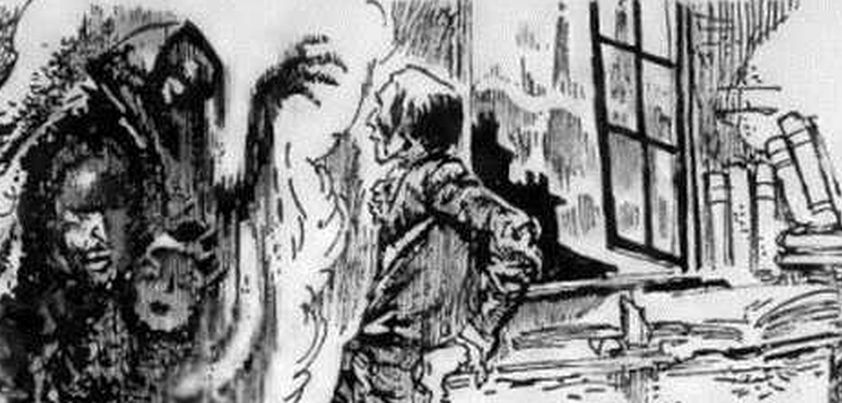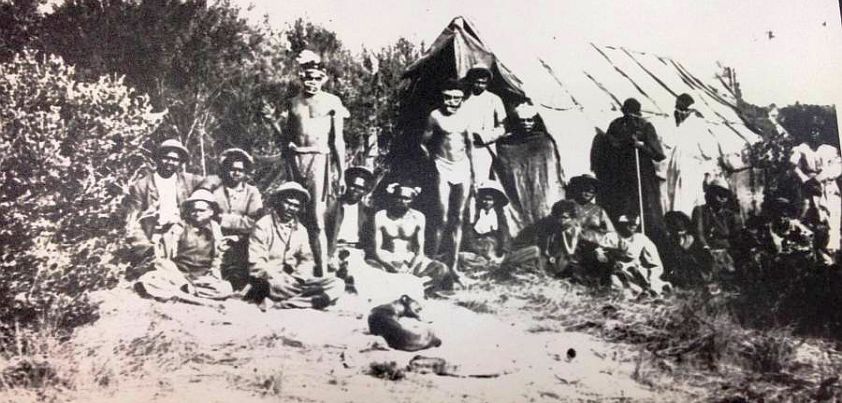 This story by Fredric Brown begins and ends with what may be the shortest horror story ever written: The last man on Earth sat alone in a room. There was a knock on the door… A scientist wakes to find himself alone in a cell. The previous night Alien invaders had collected 217 animal species, including him, for study. They then destroyed all other animal life on the planet. He convinces them that Earth is a dangerous place to live. After they have gone, he hears the second knock on the door. Themes include exploration, genocide, deceit, solitude, “duty”. More…
This story by Fredric Brown begins and ends with what may be the shortest horror story ever written: The last man on Earth sat alone in a room. There was a knock on the door… A scientist wakes to find himself alone in a cell. The previous night Alien invaders had collected 217 animal species, including him, for study. They then destroyed all other animal life on the planet. He convinces them that Earth is a dangerous place to live. After they have gone, he hears the second knock on the door. Themes include exploration, genocide, deceit, solitude, “duty”. More…
April in Paris
 The central theme of this Ursula Le Guin story is the alienation and loneliness brought about by obsession with work and lack of companionship. A 15th century French scientist, frustrated with being unable to prove a theory he had developed, decides his work is a waste of time. He experiments with black magic and is surprised when his first spell is a success, allowing him to teleport kindred spirits from the past and future to join him. Those who come are so happy in his reality that they have no desire to return. Other themes: the occult, connection. More…
The central theme of this Ursula Le Guin story is the alienation and loneliness brought about by obsession with work and lack of companionship. A 15th century French scientist, frustrated with being unable to prove a theory he had developed, decides his work is a waste of time. He experiments with black magic and is surprised when his first spell is a success, allowing him to teleport kindred spirits from the past and future to join him. Those who come are so happy in his reality that they have no desire to return. Other themes: the occult, connection. More…
The Third Wish
 This story from Joan Aiken takes the form of a “three wishes” fairy-tale. The protagonist does something very unusual for someone given three wishes. He decides not to make the third wish. When asked why, he says: I’ve learned that even if your wishes are granted they don’t always better you. Themes: 1) change (it is wrong to force change on someone who is happy as they are); 2) family (for many people, family ties are just as important as a happy marriage); and 3) sacrifice (true love means being prepared to let someone go if it makes them happier). More…
This story from Joan Aiken takes the form of a “three wishes” fairy-tale. The protagonist does something very unusual for someone given three wishes. He decides not to make the third wish. When asked why, he says: I’ve learned that even if your wishes are granted they don’t always better you. Themes: 1) change (it is wrong to force change on someone who is happy as they are); 2) family (for many people, family ties are just as important as a happy marriage); and 3) sacrifice (true love means being prepared to let someone go if it makes them happier). More…
Heart is Where the Home Is
 This Thea Astley story is set during period of the Stolen Generations: sixty-years over which up to 100,000 Australian aboriginal children were forcefully removed from their families, placed in missionary schools, and trained to work in white society. Although the story recounts an aboriginal mother’s desperate attempt to save her child, a major theme is the strong connection her people have to “home” (their clan and land). When a white farming family offers her a safe haven away from the wretched camp she lives in, her answer is Not same. Other themes include racism, brutality, family, motherhood, courage, compassion. More…
This Thea Astley story is set during period of the Stolen Generations: sixty-years over which up to 100,000 Australian aboriginal children were forcefully removed from their families, placed in missionary schools, and trained to work in white society. Although the story recounts an aboriginal mother’s desperate attempt to save her child, a major theme is the strong connection her people have to “home” (their clan and land). When a white farming family offers her a safe haven away from the wretched camp she lives in, her answer is Not same. Other themes include racism, brutality, family, motherhood, courage, compassion. More…
The Mark of Vishnu
 This story from Khushwant Singh contrasts the superstitious beliefs of a poorly educated Hindu servant (Gunga Ram) with the science taught at school to four bratty children. As the title implies, the story revolves around Gunga Ram’s devotion to the god Vishnu and what to him is a sacred snake (Kala Nag). Singh was a self-proclaimed agnostic. The story, and in particular its ironic conclusion, is a satire of organized religion and animist beliefs. Themes: faith, illiteracy, superstition vs. logic, class, (lack of) respect, change. The story’s message: blind faith can lead to disaster. More…
This story from Khushwant Singh contrasts the superstitious beliefs of a poorly educated Hindu servant (Gunga Ram) with the science taught at school to four bratty children. As the title implies, the story revolves around Gunga Ram’s devotion to the god Vishnu and what to him is a sacred snake (Kala Nag). Singh was a self-proclaimed agnostic. The story, and in particular its ironic conclusion, is a satire of organized religion and animist beliefs. Themes: faith, illiteracy, superstition vs. logic, class, (lack of) respect, change. The story’s message: blind faith can lead to disaster. More…